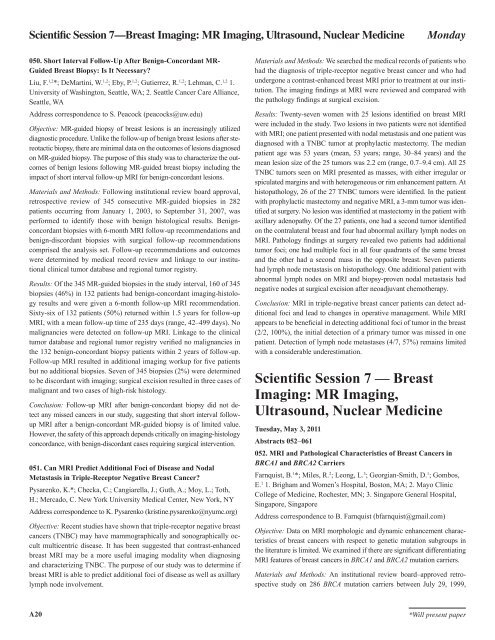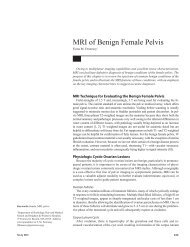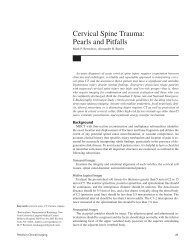Scientific Session 1 â Breast Imaging: Mammography
Scientific Session 1 â Breast Imaging: Mammography
Scientific Session 1 â Breast Imaging: Mammography
You also want an ePaper? Increase the reach of your titles
YUMPU automatically turns print PDFs into web optimized ePapers that Google loves.
<strong>Scientific</strong> <strong>Session</strong> 7—<strong>Breast</strong> <strong>Imaging</strong>: MR <strong>Imaging</strong>, Ultrasound, Nuclear MedicineMonday050. Short Interval Follow-Up After Benign-Concordant MR-Guided <strong>Breast</strong> Biopsy: Is It Necessary?Liu, F. 1,2 *; DeMartini, W. 1,2 ; Eby, P. 1,2 ; Gutierrez, R. 1,2 ; Lehman, C. 1,2 1.University of Washington, Seattle, WA; 2. Seattle Cancer Care Alliance,Seattle, WAAddress correspondence to S. Peacock (peacocks@uw.edu)Objective: MR-guided biopsy of breast lesions is an increasingly utilizeddiagnostic procedure. Unlike the follow-up of benign breast lesions after stereotacticbiopsy, there are minimal data on the outcomes of lesions diagnosedon MR-guided biopsy. The purpose of this study was to characterize the outcomesof benign lesions following MR-guided breast biopsy including theimpact of short interval follow-up MRI for benign-concordant lesions.Materials and Methods: Following institutional review board approval,retrospective review of 345 consecutive MR-guided biopsies in 282patients occurring from January 1, 2003, to September 31, 2007, wasperformed to identify those with benign histological results. Benignconcordantbiopsies with 6-month MRI follow-up recommendations andbenign-discordant biopsies with surgical follow-up recommendationscomprised the analysis set. Follow-up recommendations and outcomeswere determined by medical record review and linkage to our institutionalclinical tumor database and regional tumor registry.Results: Of the 345 MR-guided biopsies in the study interval, 160 of 345biopsies (46%) in 132 patients had benign-concordant imaging-histologyresults and were given a 6-month follow-up MRI recommendation.Sixty-six of 132 patients (50%) returned within 1.5 years for follow-upMRI, with a mean follow-up time of 235 days (range, 42–499 days). Nomalignancies were detected on follow-up MRI. Linkage to the clinicaltumor database and regional tumor registry verified no malignancies inthe 132 benign-concordant biopsy patients within 2 years of follow-up.Follow-up MRI resulted in additional imaging workup for five patientsbut no additional biopsies. Seven of 345 biopsies (2%) were determinedto be discordant with imaging; surgical excision resulted in three cases ofmalignant and two cases of high-risk histology.Conclusion: Follow-up MRI after benign-concordant biopsy did not detectany missed cancers in our study, suggesting that short interval followupMRI after a benign-concordant MR-guided biopsy is of limited value.However, the safety of this approach depends critically on imaging-histologyconcordance, with benign-discordant cases requiring surgical intervention.051. Can MRI Predict Additional Foci of Disease and NodalMetastasis in Triple-Receptor Negative <strong>Breast</strong> Cancer?Pysarenko, K.*; Checka, C.; Cangiarella, J.; Guth, A.; Moy, L.; Toth,H.; Mercado, C. New York University Medical Center, New York, NYAddress correspondence to K. Pysarenko (kristine.pysarenko@nyumc.org)Objective: Recent studies have shown that triple-receptor negative breastcancers (TNBC) may have mammographically and sonographically occultmulticentric disease. It has been suggested that contrast-enhancedbreast MRI may be a more useful imaging modality when diagnosingand characterizing TNBC. The purpose of our study was to determine ifbreast MRI is able to predict additional foci of disease as well as axillarylymph node involvement.Materials and Methods: We searched the medical records of patients whohad the diagnosis of triple-receptor negative breast cancer and who hadundergone a contrast-enhanced breast MRI prior to treatment at our institution.The imaging findings at MRI were reviewed and compared withthe pathology findings at surgical excision.Results: Twenty-seven women with 25 lesions identified on breast MRIwere included in the study. Two lesions in two patients were not identifiedwith MRI; one patient presented with nodal metastasis and one patient wasdiagnosed with a TNBC tumor at prophylactic mastectomy. The medianpatient age was 53 years (mean, 53 years; range, 30–84 years) and themean lesion size of the 25 tumors was 2.2 cm (range, 0.7–9.4 cm). All 25TNBC tumors seen on MRI presented as masses, with either irregular orspiculated margins and with heterogeneous or rim enhancement pattern. Athistopathology, 26 of the 27 TNBC tumors were identified. In the patientwith prophylactic mastectomy and negative MRI, a 3-mm tumor was identifiedat surgery. No lesion was identified at mastectomy in the patient withaxillary adenopathy. Of the 27 patients, one had a second tumor identifiedon the contralateral breast and four had abnormal axillary lymph nodes onMRI. Pathology findings at surgery revealed two patients had additionaltumor foci; one had multiple foci in all four quadrants of the same breastand the other had a second mass in the opposite breast. Seven patientshad lymph node metastasis on histopathology. One additional patient withabnormal lymph nodes on MRI and biopsy-proven nodal metastasis hadnegative nodes at surgical excision after neoadjuvant chemotherapy.Conclusion: MRI in triple-negative breast cancer patients can detect additionalfoci and lead to changes in operative management. While MRIappears to be beneficial in detecting additional foci of tumor in the breast(2/2, 100%), the initial detection of a primary tumor was missed in onepatient. Detection of lymph node metastases (4/7, 57%) remains limitedwith a considerable underestimation.<strong>Scientific</strong> <strong>Session</strong> 7 — <strong>Breast</strong><strong>Imaging</strong>: MR <strong>Imaging</strong>,Ultrasound, Nuclear MedicineTuesday, May 3, 2011Abstracts 052-061052. MRI and Pathological Characteristics of <strong>Breast</strong> Cancers inBRCA1 and BRCA2 CarriersFarnquist, B. 1 *; Miles, R. 2 ; Leong, L. 3 ; Georgian-Smith, D. 1 ; Gombos,E. 1 1. Brigham and Women’s Hospital, Boston, MA; 2. Mayo ClinicCollege of Medicine, Rochester, MN; 3. Singapore General Hospital,Singapore, SingaporeAddress correspondence to B. Farnquist (bfarnquist@gmail.com)Objective: Data on MRI morphologic and dynamic enhancement characteristicsof breast cancers with respect to genetic mutation subgroups inthe literature is limited. We examined if there are significant differentiatingMRI features of breast cancers in BRCA1 and BRCA2 mutation carriers.Materials and Methods: An institutional review board–approved retrospectivestudy on 286 BRCA mutation carriers between July 29, 1999,A20*Will present paper
















